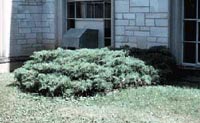Resource Library
Plant of the Week: Pfitzer Juniper
The University of Arkansas System Division of Agriculture does not promote, support or recommend plants featured in "Plant of the Week." Please consult your local Extension office for plants suitable for your region.
Plant of the Week
Pfitzer Juniper
Latin: Juniperus chinensis 'Pfitzeraiana'

Of late, I've been amusing myself looking at nursery catalogs and old books from the
turn of the 20th century to see what plants were being grown back then. We all like
to celebrate important milestones, and it’s likely that the traditional press will
miss this one, so the task falls to me to inform you, faithful reader, that this year
marks the 100th anniversary of the introduction of Pfitzer juniper into the United
States.
This interesting factoid will no doubt show up on Who Wants to Be a Millionaire and
could pave your way to financial independence.
The Pfitzer juniper is one of those old-fashioned junipers gardeners quickly inform
me they hate. There are two plants often confused when the phrase "spreading juniper"
comes up. The gray-green spreader that grows about 6 feet high and 10 feet wide is
the Pfitzer. The other plant, the Hetizi juniper, has blue-gray foliage and grows
larger, maybe 10 feet tall by 15 wide. The Hetizi has a more rambunctious nature than
the Pfitzer.
If you spend much time around old places – say a college campus, a cemetery or the
like – you no doubt know Pfitzer well. It has typical juniper-like foliage, which
tends to be somewhat droopy at the ends. It’s a male clone, so it doesn’t produce
the typical waxy blue balls of other junipers.
The roots of Pfitzer are rather obscure. According to Krussmann's "Manual of Cultivated
Conifers," it’s likely that seeds of Chinese juniper were collected in the Ho Lo Shan
range in Mongolia in 1866 when a Jesuit Priest named Armund David was serving as traveling
naturalist for the French church. The seeds would have gone to the botanic garden
in Paris.
It was Father David who became the first Westerner to catch a giant panda and ship
it to the West, where it promptly died because it's finicky diet was not yet understood.
At any rate, a plant that sounds a lot like the Pfitzer juniper was offered in 1876
by Simon Louis Nursery in Metz, France. It became widely known in Germany and Belgian
during this period. The naming of Pfitzer fell to L. Spath, who named it after his
friend, W. Pfitzer, in 1899. I find mention of a Spath Nursery in Germany that was
breeding plants around the turn of the century, but details are scanty.
The arrival of one of the 20th century's most important landscape shrubs in the U.S.
is equally obscure. It likely came in to one of the large Eastern nurseries with a
reputation of new plant introductions, such as the Hick's Nursery on Long Island.
At any rate, it was widely spread throughout the U.S. nursery industry by the end
of WWI.
The nursery industry back in 1900 was an industry in transition. The industry largely
originated to grow fruit trees for farmers. As late as 1890, about 75 percent of its
production was fruit trees. By 1900 it had shifted to 50-50 fruits and ornamentals.
By 1925 it was 75 percent ornamentals and 25 percent fruit.
Most of the nurseries were located in zones 5 and 6, and nearly all of the plants
were sold bare root and shipped to distant markets by boxcar. The deciduous shrubs
common around old homes – forsythia, japonica, fragrant honeysuckle and mock orange
– date from this era of bare root nursery sales.
It wasn’t until the 1930's that the practice of balling and burlapping shrubs, a
requirement for a conifer such as Pfitzer juniper, became common in many wholesale
nurseries.
Pfitzer juniper is a survivor. Gardeners often favor more colorful or more beautiful
plants, but many of these lack the gumption to survive long term. Pfitzer will take
an extreme amount of heat, cold and drought conditions, which it no doubt had to survive
on the steeps of Mongolia. The only real enemy of the Pfitzer, other than hedge clippers
in the hands of an unlicensed novice, is the bagworm. We will explore this troublesome
pest in a future article.
By: Gerald Klingaman, retired
Extension Horticulturist - Ornamentals
Extension News - January 26, 2001
The University of Arkansas System Division of Agriculture does not maintain lists of retail outlets where these plants can be purchased. Please check your local nursery or other retail outlets to ask about the availability of these plants for your growing area.